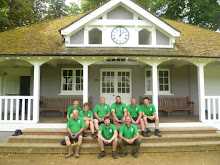 |
| Young Bramley Apple Tree |
Passionate about fruit trees, particularly apple trees, Kieron has long held a dream of creating an 'Oxfordshire Family Apple Tree' in the college orchard and today that dream has become a reality. A family tree is a tree that, unlike a standard one variety tree i.e Bramley, will have numerous different varieties of apple on one tree, an extraordinary example of this can be found in the garden of Paul Barnett in Chidham, near Chichester, West Sussex, where 250 different varieties grow on one tree! (Click on this link to read an article on the
'MailOnline' dated 29th September 2013).
 |
| Grafting Kit |
With help and guidance from Chris Lanczak, Orchard Manager at Waterperry Gardens, Kieron began to transform the chosen tree, a young Bramley, in to the 14 variety family tree. Armed with the grafting kit of sharp saws, grafting knives, grafting tape and wax, a paint brush and multiple lengths of dormant one year old scion wood that had been cut from the donor trees last December, wrapped in clingfilm and refrigerated until now, the optimum grafting time, March to April when the sap starts to rise, the transformation began.
 |
| Removing The Branches |
Removing the required number of branches on the Bramley, the rootstock, and the support for the scion wood, the grafting began.
 |
| Rootstock Cut |
The method of grafting best performed at this time of year is known as
'whip and tongue', a cut is made in to the rootstock where the branch was removed to make a flap, the scion wood is cut to between three and four buds in length, an angled cut made at the base then the newly pointed end gently inserted in to the rootstock cut so that one of the buds is within it.
 |
| Scion Wood Placed Inside The Rootstock |
The cuts on both the rootstock and scion wood have exposed the trees repairing cells known as the cambium and it is these cells that will knit themselves together and join the two pieces of wood as one.
 |
| Three Pieces Of Scion Held Together By Grafting Tape |
 |
| Hot Grafting Wax |
Two to three pieces of scion wood from each variety were grafted to the cut branches of the rootstock tree and secured using grafting tape, hopefully one or two of each will successfully bind together, then all the exposed surfaces painted with hot grafting wax to seal the wounds.
 |
| Painting On The Wax |
 |
| Grafted and Waxed 'Oxford Sunrise' Scion Wood |
 |
| More Grafting |
All in all a total of 36 pieces of scion wood were grafted on to the tree but only time will tell how successful this first attempt at creating an Oxfordshire family tree will be and if one man's dream becomes a reality. A mix of culinary and dessert apples, the varieties used are:
Wardington Seedling, Corry's Wonder, Eynsham Dumpling, Peggy's Pride, Sargeant Peggy, Caudal Market, Jennifer Wastie, Old Fred, Oxford Beauty, Oxford Hoard, Oxford Sunrise, Oxford Yeoman, Oxford Conquest and Eynsham Challenger. All were raised in Eynsham, Oxfordshire apart from
Wardington Seedling which was raised in Banbury.
 |
| Three More Varieties |
 |
| The Oxfordshire Family Tree |









































